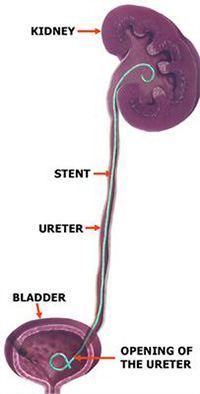Ureteric Stent Information Double J Stent
What is it?
 A thin, hollow tube placed inside the ureter during surgery to ensure drainage of urine from the kidney into the bladder. J shaped curls are present at both ends to hold the tube in place and prevent migration, hence the description "double J stent".
A thin, hollow tube placed inside the ureter during surgery to ensure drainage of urine from the kidney into the bladder. J shaped curls are present at both ends to hold the tube in place and prevent migration, hence the description "double J stent".
Purpose?
It allows the kidney to drain urine by temporarily relieving any obstruction, or to assist the kidney in passing out stone fragments into the bladder after definitive kidney stone treatment.
What symptoms will you notice?
This tube has curls at either end which keeps the stent from moving. The lower curl can irritate the bladder and make you feel the need to constantly go to the toilet to empty your bladder. It can also cause discomfort in the kidney region on urination, and at times you may notice blood in the urine.
None of these symptoms are harmful and your body gets use to the stent over time. Simple analgesics may be helpful in controlling the discomfort (Panadol or Nurofen). These symptoms resolve after stent removal.
What if there is a string tether present?
Sometimes there is a string tether attached to the ureteric stent and exits out from the bladder. This is for your benefit as it allows the stent to be removed in the office without the need for another procedure. You will be advised as to the timing of its removal after your surgery. If you accidentally dislodge the stent, you will temporarily be incontinent of urine.
If this occurs, please put on a pad and call your doctor for advice during business hours.
Important Information!
Ureteric stents are in most instances temporary and must be removed from the body after definitive treatment is completed. Occasionally, events can occur where communication and follow up is lost. It is important that you remember you have a ureteric stent and follow up with your urologist to have it removed or changed.
- Click here to download Urinary Tract “Double J”.
You will need the Adobe Reader to view and print these documents.![]()





 Menu
Menu


